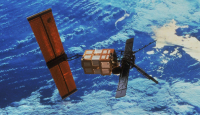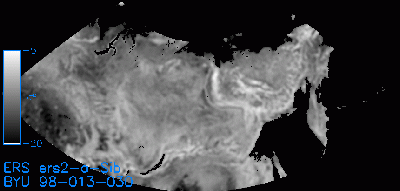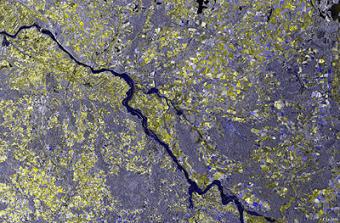Platforms: ERS-2
From
ERS (European Remote Sensing Satellite) are a family of multi-disciplinary Earth Observation Satellites.
The ERS-2 satellite was launched on 21 April 1995 by the European Space Agency (ESA) and is still orbit more than 15 years later. The Active Microwave Instrument (AMI), like its successor ASCAT, operates at a frequency in C-band (5.255 GHz) giving the instrument a near all-weather capability. Three vertically polarised (VV) antennas illuminate a single 500 km-wide swath providing backscatter measurements on a 25 km grid. Since the failure of on board tape recorder in June 2003 data is acquired in real time whenever the satellite is within visible range of a ground station. This is best demonstrated by the ERS-2 map plots on the monthly monitoring pages. Scatterometer data from ESR-2 was assimilated at the Met Office from 1998-1999 (stopped due to technical problems with the platform), but has subsequently been reintroduced operationally since 14 March 2006.
Satellite Largely identical to ERS-1. The platform is based on the design developed for the French SPOT satellite. Payload electronics accommodated in a box-shaped housing on the platform; antennas fitted to a bearing structure.
Спутник
On-board systems AMI - active microwave instrument consisting of a synthetic aperture radar (SAR) and a wind scatterometer (both in the C-band). RA- radar altimeter: takes precise measurements of the distance from the ocean surface and of wave heights. ATSR - along-track scanning radiometer (operating in the infrared and visible ranges): measures sea surface temperatures and the vegetation cover of land surfaces. GOME - global ozone monitoring experiment, an absorption spectrometer which measures the presence of ozone, trace gases and aerosols in the stratosphere and troposphere. MS - microwave sounder: supplies data on atmospheric humidity. PRARE - precise range and range rate equipment: ERS orbit and trajectory determination. LRR - laser reflector: determines satellite position using ground-based laser stations. IDHT - instrument data handling and transmission: temporary on-board data storage by means of two 6.5 GBit tape recorders, equivalent to the data volume acquired in one orbit. Recording, formatting and transmission of data at 105 Mbit/s (transmission of SAR imaging data in real time), or 15 Mbit/s (transfer from tape recorder).
Dimensions Overall height: 11.8 m Solar generator: 11.7 x 2.4 m SAR antenna: 10 x 1 m Total mass: 2516 kg
Результат
Источники
Описание: https://earth.esa.int/ers/eeo/satconc2.html, http://research.metoffice.gov.uk/research/interproj/nwpsaf/scatter_report/ers2.html Изображения: http://research.metoffice.gov.uk/research/interproj/nwpsaf/scatter_report/ers2.html, http://www.scp.byu.edu/movies/ERS/ersmovie.html, http://phys.org/news64157030.html



